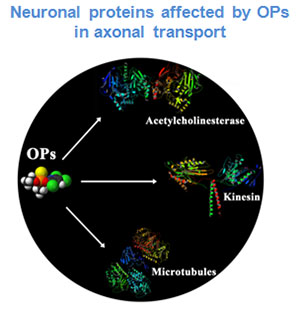


Posted April 28, 2015
Alvin Terry, Ph.D., Georgia Regents University
 One-fourth of the United States Veterans who served in the 1990-1991 Persian Gulf War are affected by a complex of multiple symptoms known as Gulf War Illness (GWI), whose etiology remains unclear. Among the potential contributing factors to GWI, exposures to organophosphate (OP) based insecticides and nerve agent-OPs have been implicated. OPs are a highly reactive species of molecules that are toxic to humans and target organisms. They have been well-studied in plants, insects, and higher animals and are known to permanently attach to the active site of a key protein in nerve signal transmission called acetylcholinesterase. This binding of acetylcholinesterase results in acute, radically elevated nerve signaling referred to as "cholinergic" toxicity. There is also evidence that OP exposures not associated with cholinergic toxicity may result in prolonged neurological deficits.
One-fourth of the United States Veterans who served in the 1990-1991 Persian Gulf War are affected by a complex of multiple symptoms known as Gulf War Illness (GWI), whose etiology remains unclear. Among the potential contributing factors to GWI, exposures to organophosphate (OP) based insecticides and nerve agent-OPs have been implicated. OPs are a highly reactive species of molecules that are toxic to humans and target organisms. They have been well-studied in plants, insects, and higher animals and are known to permanently attach to the active site of a key protein in nerve signal transmission called acetylcholinesterase. This binding of acetylcholinesterase results in acute, radically elevated nerve signaling referred to as "cholinergic" toxicity. There is also evidence that OP exposures not associated with cholinergic toxicity may result in prolonged neurological deficits.
In addition to acetylcholinesterase, OPs have been shown to bind proteins essential to a nerve cell process called "axonal transport." Axonal transport is a cellular process that moves proteins, vesicles, and energy sources along the long fiber or "axon" of a nerve cell. Dr. Alvin Terry of Georgia Regents University hypothesized that the attachment of OPs to the motor proteins, microtubule and kinesin, involved in this transport process following exposure might impede this mechanism and produce neural dysfunction.
With funding provided by an Investigator-Initiated Research Award from the CDMRP Gulf War Illness Research Program, Dr. Terry and colleagues explored this hypothesis. By monitoring axonal transport using a technique known as manganese-enhanced magnetic resonance imaging (MEMRI), Dr. Terry found that axonal transport was impaired in the brains of living rats after treatment with a well-known insecticide OP called chlorpyrifos (CPF). Using doses of CPF well below that known to cause cholinergic toxicity, a single subcutaneous injection of CPF did not change axonal transport in the optic nerves of exposed animals; however, 14 days of repeated exposure to CPF did produce decreased axonal transport as measured by MEMRI. The inhibition of transport was evident even 30 days after the OP dosing had ceased. Dr. Terry and colleagues also established time course and dose-effect relationships of CPF on transport. These results indicate that repeated exposures to the pesticide CPF, at doses below those associated with acute toxicity can result in persistent alterations in axonal transport in the brain.
In new studies that are ongoing, Dr. Terry and his collaborators are investigating another OP called DFP (diisopropylfluorophosphate), with a chemical structure similar to the nerve agent sarin, for effects on axonal transport in the brains of living rats. Given the fundamental importance of axonal transport to neuronal function, the results of Dr. Terry's investigations may in part explain some of the long-term neurological effects observed in humans who have been repeatedly exposed to OPs.

Publication:
Hernandez CM, Beck WD, Naughton SX, Poddar I, Adam B, Yanasak N, Middleton C, and Terry A. 2015. Repeated exposure to chlorpyrifos leads to prolonged impairments of axonal transport in the living rodent brain. Neurotoxicology 47:17-26.
Links:














